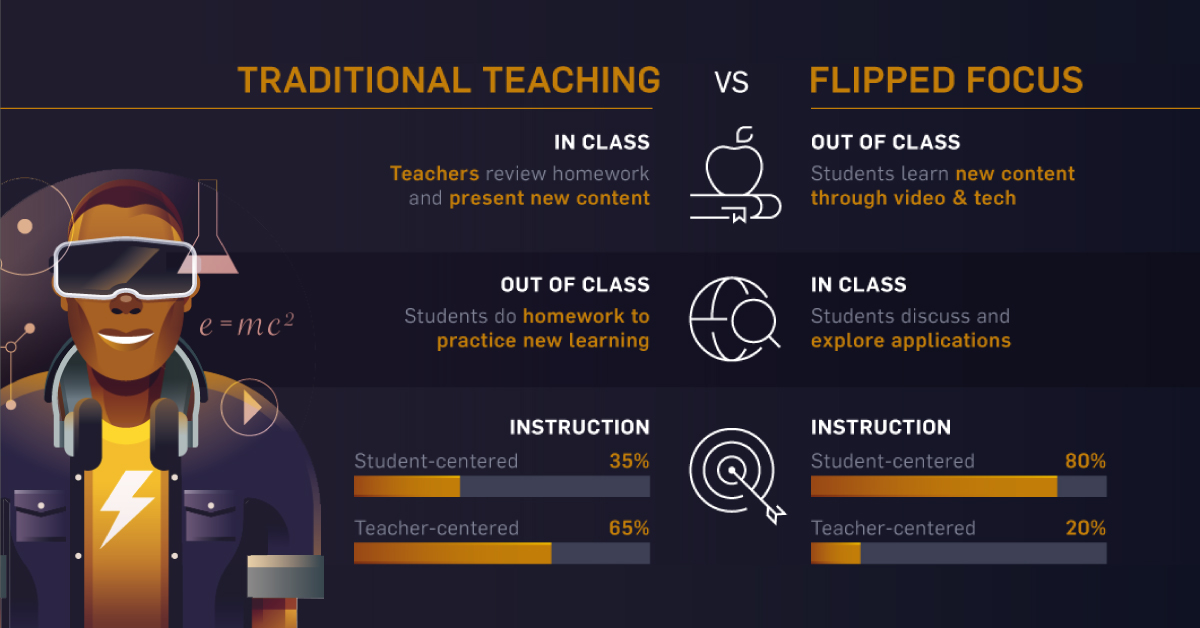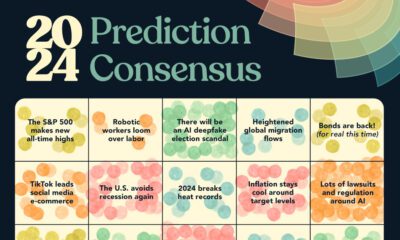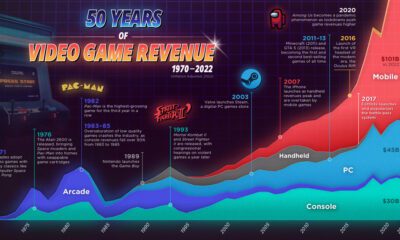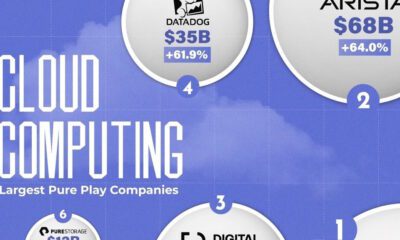Technology
How Technology is Shaping the Future of Education
Technology has transformed almost every aspect of our lives, and now it seems that education systems around the world are due for an update.
Educators are tapping into the digital revolution and adopting new technologies to help students reach their full potential, but can they adapt quickly enough to prepare children for the changing future of work?
The Growing Role of Tech in Classrooms
Today’s infographic from Best Education Degrees explores the different ways technology is transforming classrooms, and disrupting education as we know it.

The Next Generation
Although some might view technology as pervasive, for younger generations, it is ever-present.
Children and young adults make up one-third of all internet users, so it’s no surprise that they are more hyper-connected and digitally savvy than their parents.
The combination of evolving educational needs for children and a more uncertain future of work means that updating what children learn, and how they learn it, has become a crucial issue for schools and colleges—but what should be prioritized?
Classrooms 2.0
In a survey of 1,400 educators, the majority of them say they believe that classrooms of the future will be centered around self-paced and personalized learning.
This student-centric approach would allow children to choose their own pace and learning objectives based on individual interests—all of which could be guided by artificial intelligence, chatbots, and video-based learning.
Artificial Intelligence
Artificial intelligence in education typically focuses on identifying what a student does or doesn’t know, and then subsequently developing a personalized curricula for each student.
The AI-powered language learning platform Duolingo is one of the most downloaded education apps globally, with more than 50 million installs in 2018. The platform single-handedly challenges the notion of traditional learning, with a study showing that spending just 34 hours on the app equates to an entire university semester of language education.
AI-driven applications in education are still in their infancy, but Duolingo’s success demonstrates the growth potential in the sector. In fact, the nascent market for AI in education is expected to reach $6 billion by the year 2025. Over half of this will come from China and the U.S., with China leading globally.
Chatbots
Chatbots are also quickly becoming a fundamental tool in next generation education. Designed to simplify the interaction between student and computer, chatbots provide a wide range of benefits, including:
- Spaced interval learning: Uses algorithms and repetition to optimize memorization
- Immediate feedback: Papers can be graded with 92% accuracy and in a faster time than teachers
- Self-paced learning: Tracks a student’s performance and guides them based on their individual needs
This innovative technology is arming educators with new strategies for more engaged learning, whilst simultaneously reducing their workload.
Video Learning
Although video-based learning may not necessarily be considered as innovative as artificial intelligence or chatbots, 98% of educators view it as a vital component in personalized learning experiences. Most institutions report incorporating video into their curriculums in some way, but even higher demand for video-based learning may come from students in the near future.
This is due to the fact that video learning increases student satisfaction by 91%, and student achievements by 82%, which could be why educators are increasingly using video for tasks like:
- Providing material for student assignments
- Giving feedback on assignments
- Flipped instruction (blended learning) exercises
A flipped classroom overturns conventional learning by focusing on practical content that is delivered online and often outside the classroom.
The Battle Between Traditional and Tech
Flipping classrooms is a trend that has gained momentum in recent years—and may be considered to be a radical change in how students absorb information. The relatively new model also eliminates homework, by empowering students to work collaboratively on their tasks during class time.
Although new models of learning are disrupting the status quo of traditional learning, could the increasing amount of time children spend in front of screens be detrimental?
Research has shown that children are more likely to absorb information from books rather than screens. There has also been an evident increase in low-tech or tech-free schools that believe that human interaction is paramount when it comes to keeping children engaged and excited to learn.
Creating First-Class Humans
Although we may not be in the era of iTeachers just yet, the benefits of technology as teaching aids are undeniable. However, what is more important is that these aids are used in tandem with developmental and educational psychology—ultimately keeping students rather than technology at the core of education.
The future will be about pairing the artificial intelligence of computers with the cognitive, social and emotional capabilities of humans, so that we educate first-class humans, not second-class robots”
—OECD, Trends Shaping Education report
After all, how children develop these skills is perhaps less important than their ability to navigate change, as that is the only thing that will remain constant.
Brands
How Tech Logos Have Evolved Over Time
From complete overhauls to more subtle tweaks, these tech logos have had quite a journey. Featuring: Google, Apple, and more.

How Tech Logos Have Evolved Over Time
This was originally posted on our Voronoi app. Download the app for free on iOS or Android and discover incredible data-driven charts from a variety of trusted sources.
One would be hard-pressed to find a company that has never changed its logo. Granted, some brands—like Rolex, IBM, and Coca-Cola—tend to just have more minimalistic updates. But other companies undergo an entire identity change, thus necessitating a full overhaul.
In this graphic, we visualized the evolution of prominent tech companies’ logos over time. All of these brands ranked highly in a Q1 2024 YouGov study of America’s most famous tech brands. The logo changes are sourced from 1000logos.net.
How Many Times Has Google Changed Its Logo?
Google and Facebook share a 98% fame rating according to YouGov. But while Facebook’s rise was captured in The Social Network (2010), Google’s history tends to be a little less lionized in popular culture.
For example, Google was initially called “Backrub” because it analyzed “back links” to understand how important a website was. Since its founding, Google has undergone eight logo changes, finally settling on its current one in 2015.
| Company | Number of Logo Changes |
|---|---|
| 8 | |
| HP | 8 |
| Amazon | 6 |
| Microsoft | 6 |
| Samsung | 6 |
| Apple | 5* |
Note: *Includes color changes. Source: 1000Logos.net
Another fun origin story is Microsoft, which started off as Traf-O-Data, a traffic counter reading company that generated reports for traffic engineers. By 1975, the company was renamed. But it wasn’t until 2012 that Microsoft put the iconic Windows logo—still the most popular desktop operating system—alongside its name.
And then there’s Samsung, which started as a grocery trading store in 1938. Its pivot to electronics started in the 1970s with black and white television sets. For 55 years, the company kept some form of stars from its first logo, until 1993, when the iconic encircled blue Samsung logo debuted.
Finally, Apple’s first logo in 1976 featured Isaac Newton reading under a tree—moments before an apple fell on his head. Two years later, the iconic bitten apple logo would be designed at Steve Jobs’ behest, and it would take another two decades for it to go monochrome.
-

 Green1 week ago
Green1 week agoRanked: The Countries With the Most Air Pollution in 2023
-

 Automotive2 weeks ago
Automotive2 weeks agoAlmost Every EV Stock is Down After Q1 2024
-

 AI2 weeks ago
AI2 weeks agoThe Stock Performance of U.S. Chipmakers So Far in 2024
-

 Markets2 weeks ago
Markets2 weeks agoCharted: Big Four Market Share by S&P 500 Audits
-

 Real Estate2 weeks ago
Real Estate2 weeks agoRanked: The Most Valuable Housing Markets in America
-

 Money2 weeks ago
Money2 weeks agoWhich States Have the Highest Minimum Wage in America?
-

 AI2 weeks ago
AI2 weeks agoRanked: Semiconductor Companies by Industry Revenue Share
-

 Travel2 weeks ago
Travel2 weeks agoRanked: The World’s Top Flight Routes, by Revenue















